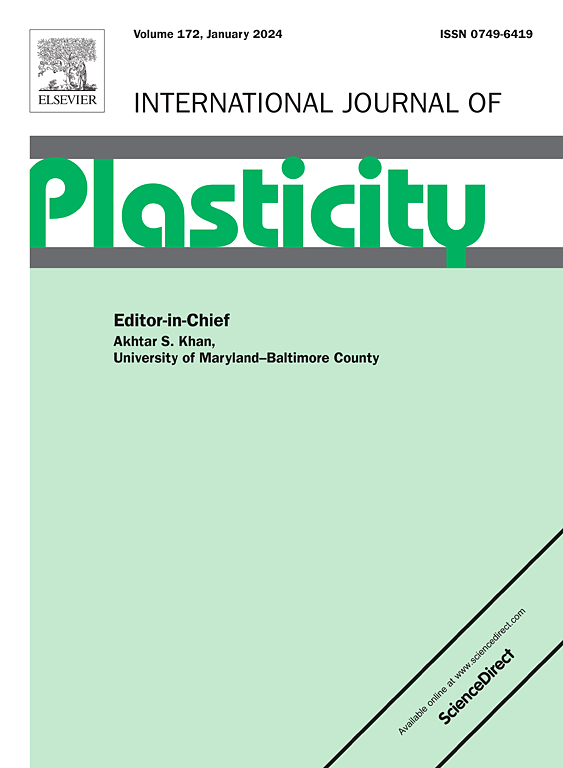包括结晶动力学在内的玻璃纤维增强聚酰胺 6 各向异性热机械耦合结构模型
IF 9.4
1区 材料科学
Q1 ENGINEERING, MECHANICAL
引用次数: 0
摘要
为了在纤维增强聚合物(frp)的工业热成型中实现工艺稳定性,通常需要成本和时间密集的试错过程。实验边界条件以及材料组成和组件设计优化高度依赖于与各种材料尺度和成分相关的材料现象。因此,有必要开发针对实验结果进行验证的有限元本构模型,并将各种材料现象纳入其中,以减少实验工作量,并通过可靠的预测来评估复合材料的性能。在这项工作中,以热力学一致的方式扩展了现有的聚酰胺6热机械耦合本构模型,以表征各向异性复合行为,包括各向异性传导、热膨胀以及与不可逆过程相关的内部热产生。此外,结合实验标准(S-DSC)和闪蒸(F-DSC)差示扫描量热法的结晶过程。确定了均质宏观材料配方的热力学模型参数,并用实验和虚拟结果数据库成功验证了模型响应。最后,在几个热机械结构计算中评估了模型的能力,包括与实验结果比较的3D热成型实例。特别地,研究了各向异性对材料自热、热膨胀和晶体状态的影响,证明了这种新方法在未来有效、准确地预测frp的潜力。我们的源代码、数据和示例输入文件可从https://doi.org/10.5281/zenodo.15052983获得。本文章由计算机程序翻译,如有差异,请以英文原文为准。
An anisotropic thermo-mechanically coupled constitutive model for glass fiber reinforced polyamide 6 including crystallization kinetics
In order to achieve process stability in the industrial thermoforming of fiber reinforced polymers (FRPs), typically, cost- and time-intensive trial-and-error-processes are required. The experimental boundary conditions, as well as the material composition and component design optimization, are highly dependent on material phenomena related to various material scales and constituents. It is therefore necessary to develop finite element constitutive models that are validated against experimental results and incorporate various material phenomena in order to reduce the experimental effort and evaluate the composite’s performance with reliable predictions. In this work, an existing thermo-mechanically coupled constitutive model for polyamide 6 is extended in a thermodynamically consistent manner to represent the anisotropic composite behavior, including anisotropic conduction, thermal expansion as well as internal heat generation associated with irreversible processes. Furthermore, the crystallization process is incorporated using experimental standard (S-DSC) and flash (F-DSC) differential scanning calorimetry results. The thermal and mechanical model parameters of the homogenized macroscopic material formulation are identified and the model response is successfully validated with a data base comprising both experimental and virtual results. Finally, the model capabilities are assessed in several thermo-mechanical structural computations, including a 3D thermoforming example in comparison with experimental results. In particular, the influence of the anisotropy on material self-heating, thermal expansion and the resulting crystalline state is investigated, demonstrating the potential of this new approach to efficiently and accurately predict FRPs in the future. Our source code, data, and exemplary input files are available under https://doi.org/10.5281/zenodo.15052983.
求助全文
通过发布文献求助,成功后即可免费获取论文全文。
去求助
来源期刊

International Journal of Plasticity
工程技术-材料科学:综合
CiteScore
15.30
自引率
26.50%
发文量
256
审稿时长
46 days
期刊介绍:
International Journal of Plasticity aims to present original research encompassing all facets of plastic deformation, damage, and fracture behavior in both isotropic and anisotropic solids. This includes exploring the thermodynamics of plasticity and fracture, continuum theory, and macroscopic as well as microscopic phenomena.
Topics of interest span the plastic behavior of single crystals and polycrystalline metals, ceramics, rocks, soils, composites, nanocrystalline and microelectronics materials, shape memory alloys, ferroelectric ceramics, thin films, and polymers. Additionally, the journal covers plasticity aspects of failure and fracture mechanics. Contributions involving significant experimental, numerical, or theoretical advancements that enhance the understanding of the plastic behavior of solids are particularly valued. Papers addressing the modeling of finite nonlinear elastic deformation, bearing similarities to the modeling of plastic deformation, are also welcomed.
 求助内容:
求助内容: 应助结果提醒方式:
应助结果提醒方式:


